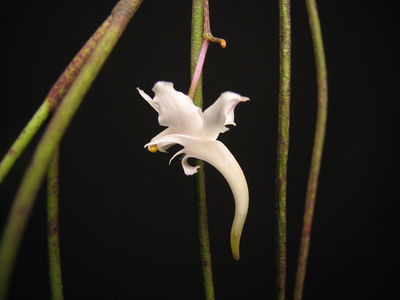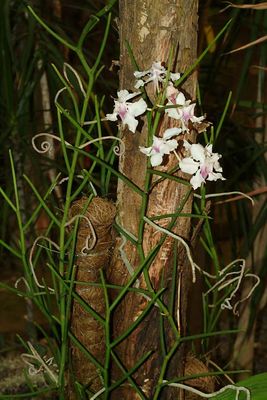-
Ecology
-
Species are terrestrial in open swamps or epiphytic in forests at 0–2400 m. Papilionanthe hookeriana (Rchb.f.) Schltr. occurs as terrestrial in full sun in swamps near sea level in Peninsular Malaysia and Borneo, usually in deep peaty soils, often growing with shrubs and tall grasses for support. The swamps are subject to seasonal flooding when the roots become submerged; this species has become scarce in both areas due to over-collection and burning of peat-swamps. Papilionanthe teres is epiphytic on tree trunks in open forests or at forest margins at 500–900 m in China; it is recorded as an epiphyte on tall forest trees at 200– 2400 m in Bhutan and occurs on trees in scrub or on rocks at 200 m and as an epiphyte on Butia Becc. (Arecaceae) at 500 m in Thailand.
-
General Description
-
Scrambling terrestrial or epiphytic herbs. Stem climbing or pendent, terete, elongate, branching or not. Leaves distichous, fleshy, terete, channelled adaxially, articulate to a sheathing base; sheaths coriaceous, tightly enclosing stem, persistent. Inflorescence lateral, 1- to several-flowered. Flowers resupinate. Sepals and petals free, subsimilar, spreading, petals usually larger. Labellum broadly adnate to column foot, non-articulate, spurred, variously trilobed, side lobes erect, either parallel to or embracing column, midlobe often dilated and bi- or trilobed; spur funnel-shaped, conical to long horn-shaped, without interior callosities. Column subterete, foot prominent; pollinia two, shortly cleft, waxy, attached by a broadly triangular or subquadrate stipe to a large viscidium; rostellum beaked.
-
Distribution
-
Papilionanthe consists of 12 species collectively distributed in India, China, Southeast Asia, and the Malay Archipelago.






